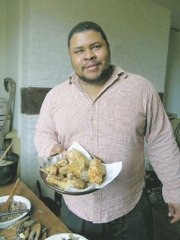<i>Michael Twitty, a leading expert on African-American foodways, will return to the Alexandria Black History Museum on March 28 to discuss the use of open hearths, stew stoves, special tools and pots that gave certain foods their unique flavor. The free lecture, which will be from from 11 a.m. to 12:30 p.m., will also discuss the importance of tradition, nature, and availability of ingredients in Afro-Virginian cooking. His book, "Fighting Old Nep: The Foodways of Enslaved Afro-Marylanders 1634-1864," will be available for purchase. Reservations are requested, as seating is limited. For more information or to make a reservation, please call 703-838-4356.</i>
<b>How did you become interested in the subject of African-American diet and food preparation?</b>
When I was a kid I was surrounded by a family that treasured its own history and the history of all people of African descent. What intrigued me the most our folk culture, especially that of enslaved people in the South and their forebears from West and Central Africa. I’ve always been interested in food. As an African-American kid you wonder — OK that ethnic group has their way of cooking and eating, what about us? I interviewed my grandparents, learned to cook, garden, fish, hunt and raise livestock through my parents, uncles, aunts and grandmother. That’s how it all started.
<b>What is distinctive about African-American foodways?</b>
African-American foodways are based on a food heritage brought from Africa transformed and adapted to the ways and ingredients of the Americas. Native America is in it, so is Western Europe. It’s our edible jazz, and unlike any other cuisine it fits like a puzzle piece with our spirituality, fashion, music, dance, oral tradition and intellect. It’s call and response you can eat.
<b>What role did the availability of ingredients play in Afro-Virginian cooking?</b>
You didn’t have much. Imagine a larder without salt, pepper, wheat flour, butter, milk, sugar, eggs or spices — all the staple ingredients of a modern American kitchen. But unlike other places where you might be completely cut off from these ingredients, enslaved Virginians’ practice of selling produce or chickens or crafts for money or barter helped them to acquire such delicacies. It’s amazing that with simple ingredients, my ancestor s were able to create a diet that sustained them despite having very little.
<b>What kinds of food was commonly found in slave quarters?</b>
Salted fish or meat, corn — measured in gallons according to the gender and workload of the person. Corn became hominy, hoecake, cornbread, corn mush and porridge. Sweet potatoes, turnip greens, cymling squash, field peas, red peppers, pole beans, watermelons and okra were all pretty common in the gardens of Virginia’s enslaved. Wild greens, fish, fruit — like persimmons or apples — and wild game like opossums and squirrel were constants in the cabins according to the seasons.
<b>What tools were used, and how did this influence the cooking?</b>
It was extremely Spartan. Iron pots or dutch ovens, frying pans or skillets, a few wooden spoons, gourds and shells and maybe stray castoffs from slave holders made up the kitchen gadgets. There were a lot of one-pot meals. Think about our slow cookers today and fried foods — foods that could either be prepared over the course of a long work day or cooked up quick at then end of one.
<b>Did slaves develop special techniques to cook their food?</b>
My ancestors often wrapped foods in leaves to steam, which was a common cooking method among Africans and Native Americans. Two other methods that came from Africa are deep frying and grilling spiced meats over smoky wood — what you might call barbecuing — are elements that enslaved Virginians drew on in creating their meals.
<b>What can modern-day people learn from studying Afro-Virginian cooking?</b>
That we are what we eat. History is really made in the kitchens and around the kitchen tables from day to day. My ancestors would have been just fine in times like these. They knew how to make something from nothing. If it wasn’t for those endless days of corn mush and salt pork, a lot of us wouldn’t be here to tell the tale.
